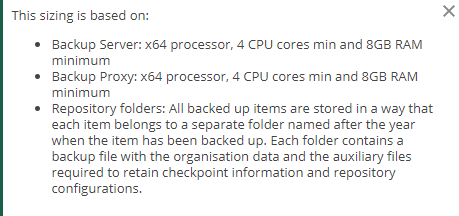
When you run a Teams backup job only these subfolders with a link to the Team will be backed up. The files stored within Microsoft Teams are stored in the respective Teams SharePoint site in subfolders based on the channel names (like General). To save repository space and processing time backup your Teams to the same repository as the Teams SharePoint sites. Thus for calculating your required backup space for Teams please refer to the respective sections for disk repos or object storage repositories. Most of the data is distributed on other Microsoft 365 services like Exchange, SharePoint and OneDrive for Business. Microsoft Teams as a service itself does only hold relatively low amounts of data. The example can be backed up by a single All-in-one Veeam Backup for Microsoft 365 server running all roles together on a server based on the recommended configuration maximums of 8 Cores and 32GB RAM. Teams (Count as 2 objects, because of complexity) The total number of objects amounts to 3,410 objects as per table below: Use case: Organization with 500 users might need to protect all mailboxes (Primary and Archive) 200 Shared Mailboxes, 10 Public MailFolders, all Personal Sites and OneDrives along with 1000 SharePoint sites and 100 Teams.


Veeam Backup for Microsoft 365 calculator Use the official Veeam Backup for Microsoft 365 calculator.VMware Link Aggregation (L2) Output Interface Calculator. To avoid these situations in future cluster set-ups, I’ve modified an Excel Spreadsheet calculator to predict these outputs by modifying IP designs. Which meant modifying one of the IP’s resulted into VMware sending out traffic over multiple NIC’s. In the above example the combination of the Source and Target IP’s were causing this behavior. Seems the load-balancing algorithm was causing this, being L2 IP Hash method ( VMware KB1004048). VMware analytics pointed out that only 1 out of 4 physical NIC’s in the Link Aggregation Group ( LAG) was being used for outbound traffic. Since I had 4 physical vmNIC’s combined I should’ve roughly gotten about 480MBps, yet speeds kept below 120MBps. VEEAM proxy’s (Hot-Add Mode) were connected to Port Groups/vSwitch holding multiple physical aggregated 1Gbps vmNIC’s.

While setting up a VEEAM Back-up & Replication infrastructure on VMware vSphere/ESXi hypervisors I ran into network performance issues.


 0 kommentar(er)
0 kommentar(er)
